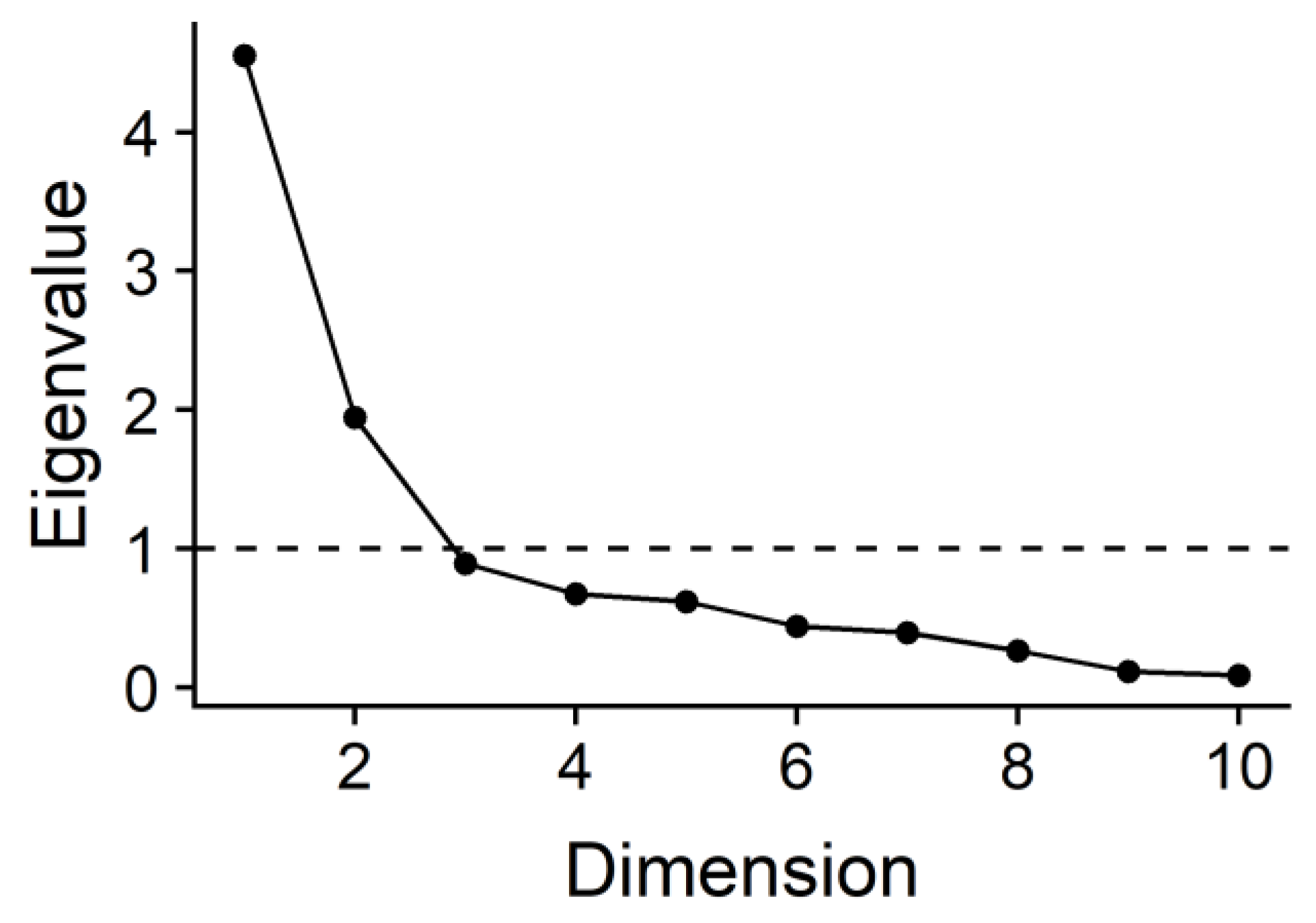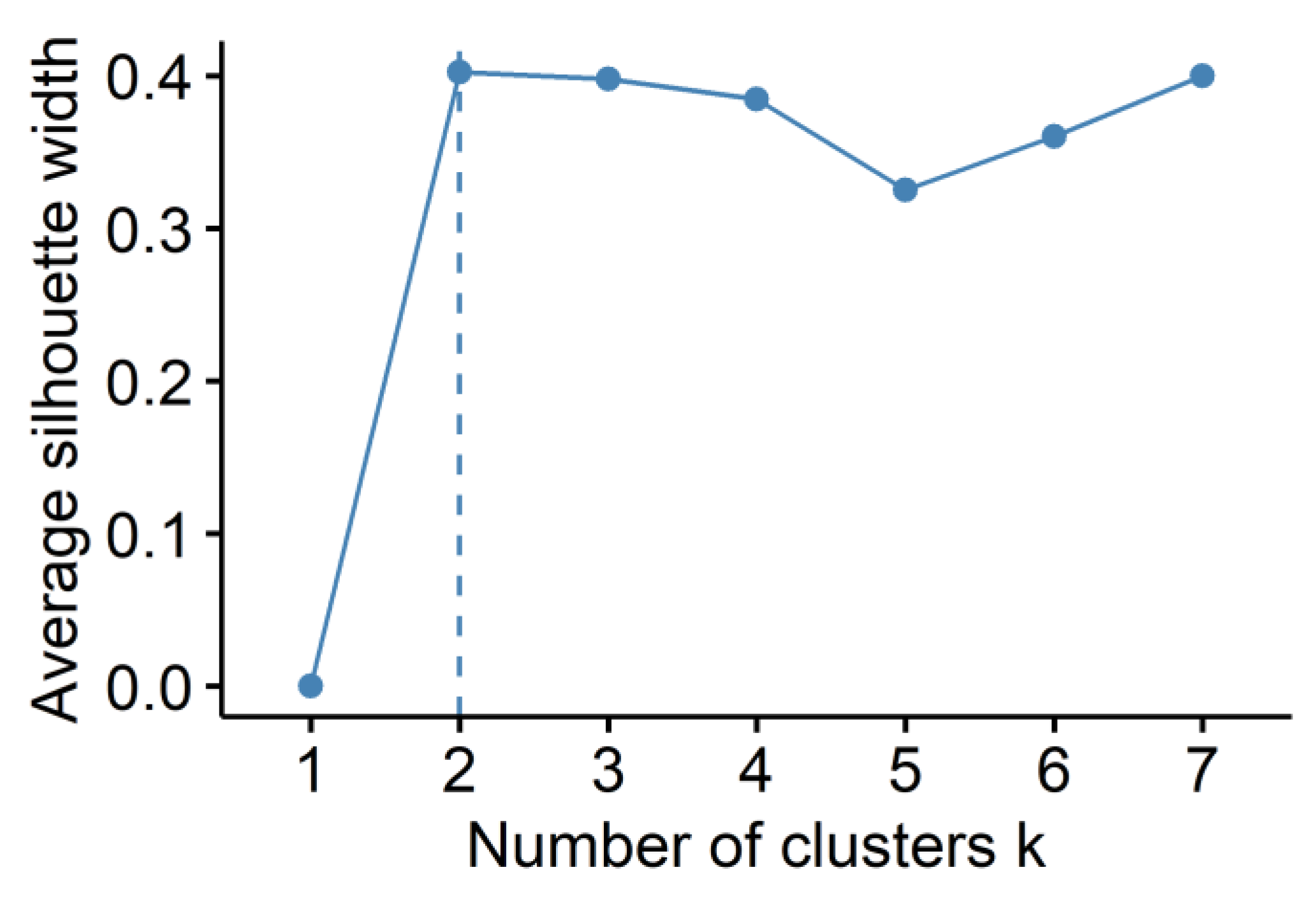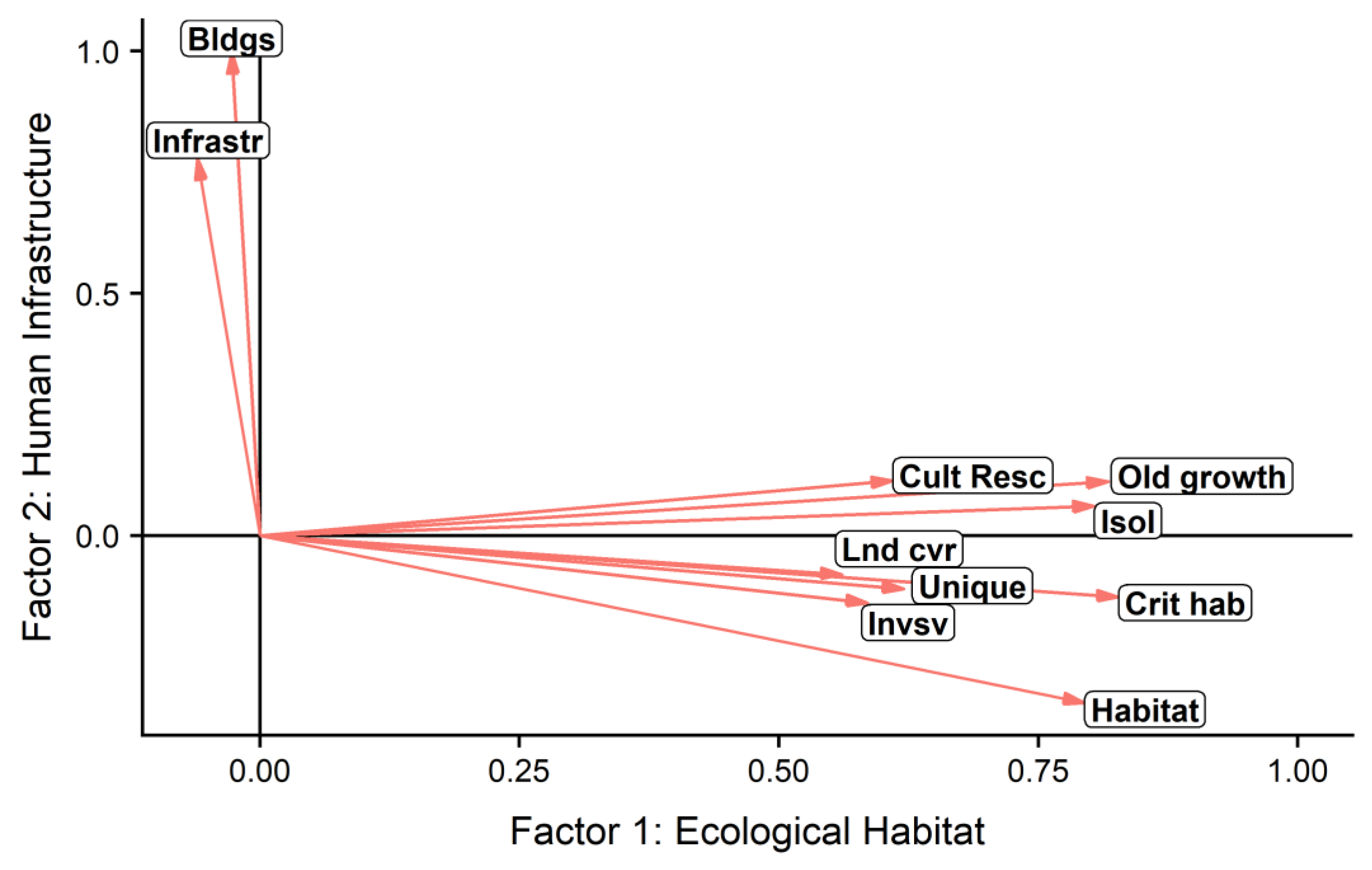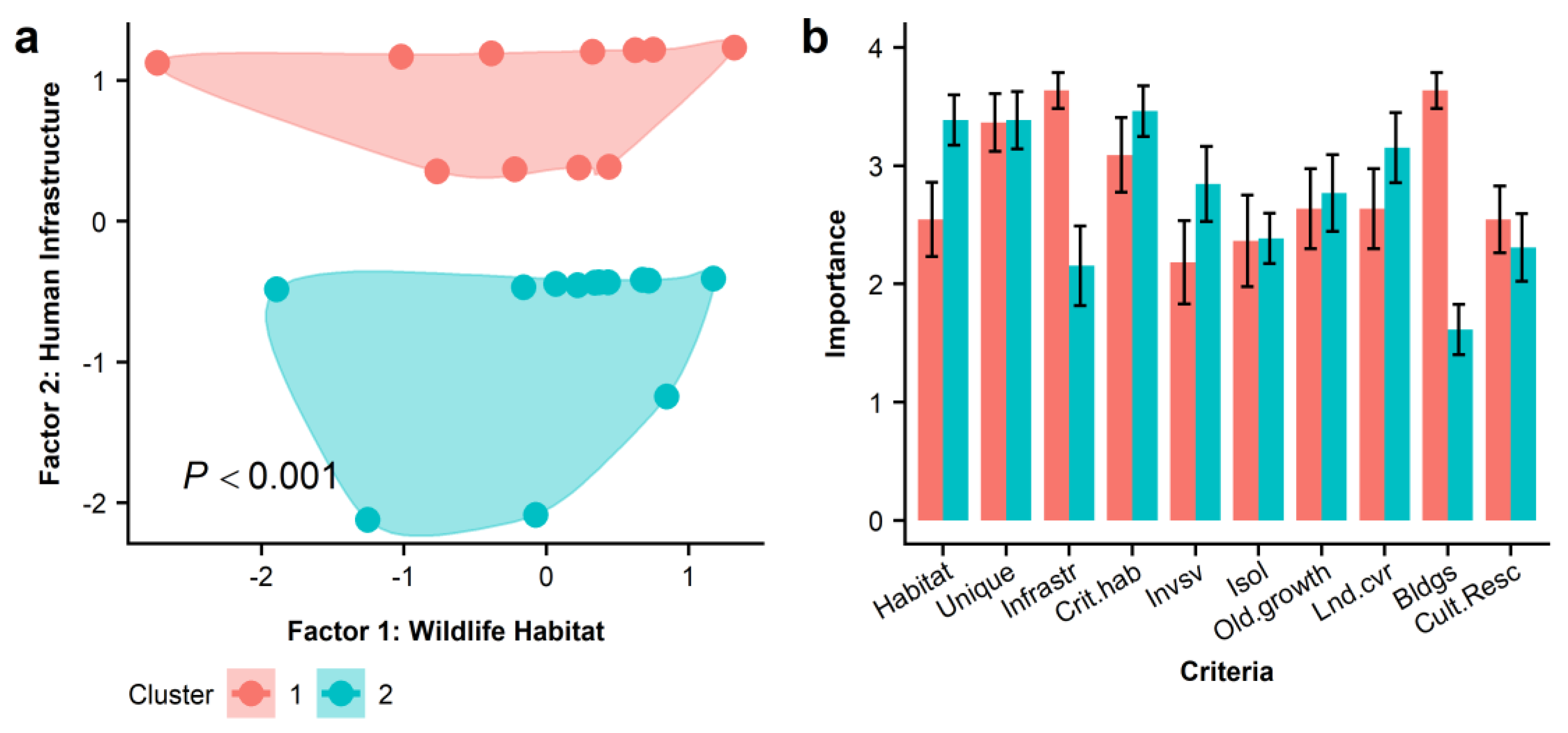An Assessment of Fire Refugia Importance Criteria Ranked by Land Managers
Abstract
1. Introduction
2. Materials and Methods
2.1. Sampling Methodology
2.2. Survey Analysis
3. Results
3.1. Respondent Demographics
3.2. Analysis
4. Discussion
5. Conclusions
Author Contributions
Funding
Acknowledgments
Conflicts of Interest
Appendix A


| Criteria | Abbreviation | Factor 1 | Factor 2 |
|---|---|---|---|
| Overall habitat value | Habitat | 0.794 | −0.345 |
| Overall uniqueness | Unique | 0.620 | −0.110 |
| Overall infrastructure | Infrastr | −0.060 | 0.778 |
| Critical habitat | Crit hab | 0.827 | −0.127 |
| Invasive species | Invsv | 0.585 | −0.139 |
| Isolation | Isol | 0.804 | 0.061 |
| Old growth structure | Old growth | 0.817 | 0.112 |
| Unique/rare land cover type | Lnd cvr | 0.561 | −0.081 |
| Presence of buildings | Bldgs | −0.027 | 0.997 |
| Cultural resource | Cult Resc | 0.609 | 0.113 |
References
- NIFC Total Wildland Fires and Acres (1926–2017). Available online: https://www.nifc.gov/fireInfo/fireInfo_stats_totalFires.html (accessed on 4 March 2019).
- Picotte, J.J.; Peterson, B.; Meier, G.; Howard, S.M. 1984–2010 trends in fire burn severity and area for the conterminous US. Int. J. Wildl. Fire 2016, 25, 413. [Google Scholar] [CrossRef]
- Ryan, K.C.; Knapp, E.E.; Varner, J.M. Prescribed fire in North American forests and woodlands: history, current practice, and challenges. Front. Ecol. Environ. 2013, 11, e15–e24. [Google Scholar] [CrossRef]
- Abatzoglou, J.T.; Williams, A.P. Impact of anthropogenic climate change on wildfire across western US forests. Proc. Natl. Acad. Sci. USA 2016, 113, 11770–11775. [Google Scholar] [CrossRef] [PubMed]
- Barbero, R.; Abatzoglou, J.T.; Larkin, N.K.; Kolden, C.A.; Stocks, B. Climate change presents increased potential for very large fires in the contiguous United States. Int. J. Wildl. Fire 2015, 24, 892. [Google Scholar] [CrossRef]
- Peterson, G.; Allen, C.R.; Holling, C.S. Ecological Resilience, Biodiversity, and Scale. Ecosystems 1998, 1, 6–18. [Google Scholar] [CrossRef]
- Stevens-Rumann, C.S.; Kemp, K.B.; Higuera, P.E.; Harvey, B.J.; Rother, M.T.; Donato, D.C.; Morgan, P.; Veblen, T.T. Evidence for declining forest resilience to wildfires under climate change. Ecol. Lett. 2018, 21, 243–252. [Google Scholar] [CrossRef]
- Haugo, R.D.; Kellogg, B.S.; Cansler, C.A.; Kolden, C.A.; Kemp, K.B.; Robertson, J.C.; Metlen, K.L.; Vaillant, N.M.; Restaino, C.M. The missing fire: quantifying human exclusion of wildfire in Pacific Northwest forests, USA. Ecosphere 2019, 10, e02702. [Google Scholar] [CrossRef]
- Kolden, C.A.; Bleeker, T.M.; Smith, A.M.S.; Poulos, H.M.; Camp, A.E. Fire effects on historical wildfire refugia in contemporary wildfires. Forests 2017, 8, 400. [Google Scholar] [CrossRef]
- Meddens, A.J.H.H.; Kolden, C.A.; Lutz, J.A.; Smith, A.M.S.S.; Cansler, C.A.; Abatzoglou, J.T.; Meigs, G.W.; Downing, W.M.; Krawchuk, M.A. Fire Refugia: What Are They, and Why Do They Matter for Global Change? Bioscience 2018, 68, 944–954. [Google Scholar] [CrossRef]
- Keppel, G.; Van Niel, K.P.; Wardell-Johnson, G.W.; Yates, C.J.; Byrne, M.; Mucina, L.; Schut, A.G.T.; Hopper, S.D.; Franklin, S.E. Refugia: Identifying and understanding safe havens for biodiversity under climate change. Glob. Ecol. Biogeogr. 2012, 21, 393–404. [Google Scholar] [CrossRef]
- Mackey, B.; Lindenmayer, D.B.; Gill, M.; McCarthy, M.; Lindesay, J. Wildlife, Fire & Future Climate; CSIRO Publishing: Collingwood, Australia, 2002; ISBN 0 643 06756 6. [Google Scholar]
- Rogeau, M.P.; Barber, Q.E.; Parisien, M.A. Effect of topography on persistent fire refugia of the Canadian Rocky mountains. Forests 2018, 9, 285. [Google Scholar] [CrossRef]
- Robinson, N.M.; Leonard, S.W.J.; Ritchie, E.G.; Bassett, M.; Chia, E.K.; Buckingham, S.; Gibb, H.; Bennett, A.F.; Clarke, M.F. REVIEW: Refuges for fauna in fire-prone landscapes: their ecological function and importance. J. Appl. Ecol. 2013, 50, 1321–1329. [Google Scholar] [CrossRef]
- Krawchuk, M.A.; Haire, S.L.; Coop, J.; Parisien, M.-A.; Whitman, E.; Chong, G.; Miller, C. Topographic and fire weather controls of fire refugia in forested ecosystems of northwestern North America. Ecosphere 2016, 7, e01632. [Google Scholar] [CrossRef]
- Camp, A.; Oliver, C.; Hessburg, P.F.; Everett, R. Predicting late-successional fire refugia pre-dating European settlement in the Wenatchee mountains. For. Ecol. Manag. 1997, 95, 63–77. [Google Scholar] [CrossRef]
- Delong, S.C.; Kessler, W.B. Ecological characteristics of mature forest remnants left by wildfire. For. Ecol. Manag. 2000, 131, 93–106. [Google Scholar] [CrossRef]
- Franklin, J.F.; Lindenmayer, D.B.; MacMahon, J.A.; Mckee, A.; Magnuson, J.; Perry, D.A.; Waide, R.; Foster, D. Threads of continuity. Conserv. Pract. 2000, 1, 8–17. [Google Scholar] [CrossRef]
- Burton, P.J.; Parisien, M.-A.; Hicke, J.A.; Hall, R.J.; Freeburn, J.T. Large fires as agents of ecological diversity in the North American boreal forest. Int. J. Wildl. Fire 2008, 17, 754–767. [Google Scholar] [CrossRef]
- Charron, I.; Greene, D.F. Post-wildfire seedbeds and tree establishment in the southern mixedwood boreal forest. Can. J. For. Res. 2002, 32, 1607–1615. [Google Scholar] [CrossRef]
- Viedma, O.; Meliá, J.; Segarra, D.; García-Haro, J. Modeling rates of ecosystem recovery after fires by using landsat TM data. Remote Sens. Environ. 1997, 61, 383–398. [Google Scholar] [CrossRef]
- Hart, S.C.; DeLuca, T.H.; Newman, G.S.; MacKenzie, M.D.; Boyle, S.I. Post-fire vegetative dynamics as drivers of microbial community structure and function in forest soils. For. Ecol. Manag. 2005, 220, 166–184. [Google Scholar] [CrossRef]
- Lindenmayer, D.B.; Franklin, J.F.; Fischer, J. General management principles and a checklist of strategies to guide forest biodiversity conservation. Biol. Conserv. 2006, 131, 433–445. [Google Scholar] [CrossRef]
- Meddens, A.J.H.; Kolden, C.A.; Lutz, J.A. Detecting unburned areas within wildfire perimeters using Landsat and ancillary data across the northwestern United States. Remote Sens. Environ. 2016, 186, 275–285. [Google Scholar] [CrossRef]
- Meddens, A.J.H.; Kolden, C.A.; Lutz, J.A.; Abatzoglou, J.T.; Hudak, A.T. Spatiotemporal patterns of unburned areas within fire perimeters in the northwestern United States from 1984 to 2014. Ecosphere 2018, 9, e02029. [Google Scholar] [CrossRef]
- Perera, A.H.; Buse, L.J. Ecology of Wildfire Residuals in Boreal Forests; John Wiley & Sons, Ltd.: Chichester, UK, 2014; ISBN 9781118870488. [Google Scholar]
- Endries, M.; Gilbert, T.; Kautz, R. Environmental planning in Florida: Mapping wildlife needs in Florida: The integrated wildlife habitat ranking system. In Proceedings of the 2003 International Conference on Ecology and Transportation, Lake Placid, NY, USA, 24–29 August 2003; Irwin, C.L., Garrett, P., McDermott, K.P., Eds.; Center for Transportation and the Environment, North Carolina State University: Raleigh, NC, USA, 2003; pp. 525–534. [Google Scholar]
- Stauffer, H.B.; Ralph, C.J.; Miller, S.L. Ranking habitat for marbled murrelets: New conservation approach for species with uncertain detection. Ecol. Appl. 2004, 14, 1374–1383. [Google Scholar] [CrossRef]
- Bodin, Ö.; Saura, S. Ranking individual habitat patches as connectivity providers: Integrating network analysis and patch removal experiments. Ecol. Modell. 2010, 221, 2393–2405. [Google Scholar] [CrossRef]
- Carroll, C.; DUunk, J.R.; Moilanen, A. Optimizing resiliency of reserve networks to climate change: multispecies conservation planning in the Pacific Northwest, USA. Glob. Chang. Biol. 2010, 16, 891–904. [Google Scholar] [CrossRef]
- Kiester, A.R.; Scott, J.M.; Csuti, B.; Noss, R.F.; Butterfield, B.; White, D. Conservation Prioritization Using GAP Data. Conserv. Biol. 1996, 10, 1332–1342. [Google Scholar] [CrossRef]
- Battaglia, M.P. Purposive Sample. Encycl. Surv. Res. Methods 2008, 645–647. [Google Scholar]
- Morgan, D.L. Snowball Sampling. SAGE Encycl. Qual. Res. Methods 2008, 816–817. [Google Scholar]
- Fox, N. Nonprobability Sampling. In The SAGE Encyclopedia of Qualitative Research Methods; SAGE Publications, Inc.: Thousand Oaks, CA, USA, 2008; p. 1043. ISBN 9781412941631. [Google Scholar]
- Dillman, D.A.; Smyth, J.D.; Christian, L.M. Internet, Phone, Mail, and Mixed-Mode Surveys: The Tailored Design Method, 4th ed.; John Wiley & Sons, Inc.: Hoboken, NJ, USA, 2014; ISBN 9781118456149. [Google Scholar]
- Abbot, J.; Chambers, R.; Harris, T.; de Merode, E.; Porter, G.; Townsend, J.; Weiner, D. Participatory GIS: oppurtunity or oxymoron? PLA Notes 1998, 27–34. [Google Scholar]
- R Core Team. R: A Language and Environment for Statistical Computing; R Foundation for Statistical Computing: Vienna, Austria, 2018. [Google Scholar]
- Fabrigar, L.R.; Wegener, D.T. Exploratory Factor Analysis; Oxford University Press: New York, NY, USA, 2011; ISBN 9780199734177. [Google Scholar]
- Cattell, R.B. The Scree Test For The Number Of Factors. Multivar. Behav. Res. 1966, 1, 245–276. [Google Scholar] [CrossRef]
- Rousseeuw, P.J. Silhouettes: A graphical aid to the interpretation and validation of cluster analysis. J. Comput. Appl. Math. 1987, 20, 53–65. [Google Scholar] [CrossRef]
- Calkin, D.E.; Cohen, J.D.; Finney, M.A.; Thompson, M.P. How risk management can prevent future wildfire disasters in the wildland-urban interface. Proc. Natl. Acad. Sci. USA 2014, 111, 746–751. [Google Scholar] [CrossRef] [PubMed]
- Ní Dhubháin, Á.; Cobanova, R.; Karppinen, H.; Mizaraite, D.; Ritter, E.; Slee, B.; Wall, S. The Values and Objectives of Private Forest Owners and Their Influence on Forestry Behaviour: The Implications for Entrepreneurship. Small-Scale For. 2007, 6, 347–357. [Google Scholar] [CrossRef]
- Martin, I.M.; Steelman, T.A. Using Multiple Methods to Understand Agency Values and Objectives: Lessons for Public Lands Management. Policy Sci. 2004, 37, 37–69. [Google Scholar] [CrossRef]
- Ray, L.A.; Kolden, C.A.; Chapin, F.S. A case for developing place-based fire management strategies from traditional ecological knowledge. Ecol. Soc. 2012, 17, 37. [Google Scholar] [CrossRef]
- Roux, D.J.; Rogers, K.H.; Biggs, H.C.; Ashton, P.J.; Sergeant, A. Bridging the science-management divide: Moving from unidirectional knowledge transfer to knowledge interfacing and sharing. Ecol. Soc. 2006, 11, 4. [Google Scholar] [CrossRef]
- Ouarmim, S.; Ali, A.A.; Asselin, H.; Hély, C.; Bergeron, Y. Evaluating the persistence of post-fire residual patches in the eastern Canadian boreal mixedwood forest. Boreas 2015, 44, 230–239. [Google Scholar] [CrossRef]




| Variable | df 1 | df 2 | Pillai | F | p |
|---|---|---|---|---|---|
| Ecosystem type | 1 | 22 | 0.548 | 1.577 | 0.218 |
| Occupational category | 1 | 22 | 0.388 | 0.824 | 0.614 |
| Refugia species of concern | 2 | 21 | 0.898 | 1.059 | 0.439 |
| Agency | 5 | 18 | 2.256 | 1.069 | 0.397 |
| Management type | 3 | 20 | 1.609 | 1.503 | 0.115 |
| Cluster | 1 | 22 | 0.864 | 8.28 | <0.001 |
© 2019 by the authors. Licensee MDPI, Basel, Switzerland. This article is an open access article distributed under the terms and conditions of the Creative Commons Attribution (CC BY) license (http://creativecommons.org/licenses/by/4.0/).
Share and Cite
Martinez, A.; Meddens, A.; Kolden, C.; Hudak, A. An Assessment of Fire Refugia Importance Criteria Ranked by Land Managers. Fire 2019, 2, 27. https://doi.org/10.3390/fire2020027
Martinez A, Meddens A, Kolden C, Hudak A. An Assessment of Fire Refugia Importance Criteria Ranked by Land Managers. Fire. 2019; 2(2):27. https://doi.org/10.3390/fire2020027
Chicago/Turabian StyleMartinez, Anthony, Arjan Meddens, Crystal Kolden, and Andrew Hudak. 2019. "An Assessment of Fire Refugia Importance Criteria Ranked by Land Managers" Fire 2, no. 2: 27. https://doi.org/10.3390/fire2020027
APA StyleMartinez, A., Meddens, A., Kolden, C., & Hudak, A. (2019). An Assessment of Fire Refugia Importance Criteria Ranked by Land Managers. Fire, 2(2), 27. https://doi.org/10.3390/fire2020027






